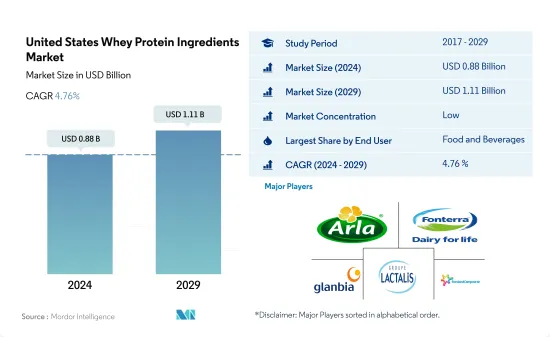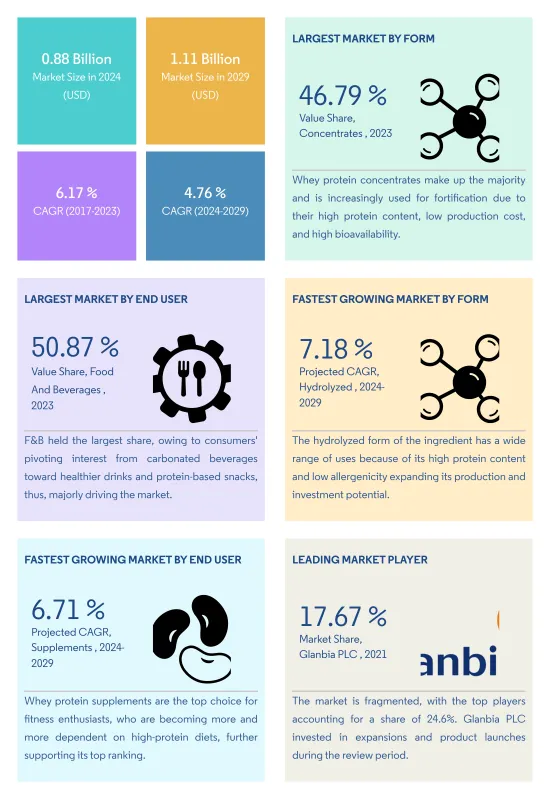Need help finding what you are looking for?
Contact Us
PUBLISHER: Mordor Intelligence | PRODUCT CODE: 1430617

PUBLISHER: Mordor Intelligence | PRODUCT CODE: 1430617
United States Whey Protein Ingredients - Market Share Analysis, Industry Trends & Statistics, Growth Forecasts (2024 - 2029)
PUBLISHED:
PAGES: 221 Pages
DELIVERY TIME: 2-3 business days
SELECT AN OPTION
The United States Whey Protein Ingredients Market size is estimated at USD 0.88 billion in 2024, and is expected to reach USD 1.11 billion by 2029, growing at a CAGR of 4.75% during the forecast period (2024-2029).


Surging sports and performance nutrition industry coupled with growing number of beauty clinics benefitted the use of whey proteins in the market
- The whey protein market comprises food and beverage and supplements as the two major applications. In 2019, the consumption volume of supplements surpassed the consumption volume of food and beverage to claim the top position among all end-user applications. This growth can be attributed to the rising number of muscle and fitness enthusiasts. This situation is increasing consumers' demand for whey protein-based sports beverages, specialized nutritional products, and other products designed to optimize athletic performance. From 2016 to 2019, the total number of memberships at fitness centers across the United States witnessed a growth of 12.04%, reaching 64.2 million memberships in 2019. However, the food and beverage industry in the United States grew by 10.57% in 2019.
- The supplements segment is likely to outpace other applications in terms of growth rate, recording a projected CAGR of 6.51% during the forecast period. The surging sports and performance nutrition industry is projected to register the fastest CAGR of 6.70%. This situation is further anticipated to drive the sales of whey protein in the supplements industry across the country.
- The other fastest-growing end-user segment for whey protein is personal care and cosmetics, which is projected to register a CAGR of 5.13% during the forecast period. Whey protein is used in anti-aging products, hair-care products, and nail-care products, among other things. The increasing number of beauty clinics, increasing per capita expenditure on personal appearance, a robust regulatory framework, and the growing beauty and cosmetics industry may boost overall demand in the future. Between 2016 and 2021, the average annual expenditure on beauty and personal care products rose by 7.04% across the United States.

United States Whey Protein Ingredients Market Trends
Sport/performance nutrition to witness significant growth during forecast period
- Rising health concerns and memberships across health clubs are primarily driving the sport/performance nutrition industry. From 2009 to 2019, the number of gyms in the United States rose by 39%. However, the industry witnessed a significant decline due to gym closures during the COVID-19 pandemic-induced nationwide lockdown in 2020. Health clubs are among the most popular sales channels for sports supplements. The closure of health clubs had a negative impact on the sales of supplements. In 2020, several gyms like Gold's Gym, Flywheel Sports, Town Sports International, and 24-Hour Fitness declared bankruptcy. Sales of sports nutrition products decreased in 2020, and the industry's overall Y-o-Y growth rate reduced by 3.37%.
- The importance of leading an active lifestyle is fueling the sports nutrition market. In 2021, 67% of US consumers aged six and above participated in fitness activities, of which 43.3% of consumers engaged in individual sports, 52.9% in outdoor sports, and 22.1% in team sports. Consumers are becoming more aware of the value of optimal nutrition and healthier lifestyles, all of which positively impact the sport nutrition supplements market.
- Sports/performance nutrition is the fastest-growing end-user segment in the US whey protein ingredients market, of which animal protein accounts for a major share of 91.1% in terms of value. The fitness industry is rapidly increasing the usage of animal protein ingredients, such as whey, collagen, and milk proteins, in nutritional supplements used for muscle or tissue repair after workouts. The rise in the availability of protein supplements, a growth in the number of recreational and lifestyle users of these products, and an increase in health awareness are expected to foster market growth over the forecast period.

Increasing dry whey production to stabilize whey protein prices during forecast period
- Whey production is mainly driven by the supply obtained from cheese production plants, accounting for a majority of the country's liquid whey production. As of April 2022, there were over 500 cheese production plants in the United States. Whey powder dominates the whey products market, closely followed by WPC. Around 934 million pounds of dry whey is produced in the country, out of which whey protein concentrate accounts for 509 million pounds. The demand is mainly driven by a strong inclination toward protein and high-protein products across the country's food and beverage market.
- Major companies are working toward securing additional whey plants. Whey has become a key resource in the dairy market. Sports and performance nutrition products are driving strong growth in the high-end protein ingredients sector. With the rising demand for WPC, there is a shift in preference from dry whey to WPC. However, the fluctuating prices may hinder the production of WPC in the market. The average price of WPC 34% was USD 1.2149 in November 2021, compared to USD 0.9124 in 2020.
- In 2020, the overall whey production declined due to the pandemic because production plants had shut down across the nation. The production volume of dry whey was nearly 951 million pounds, which was down by 2.7%. The production volume of WPC was about 478 million pounds, which was down by 2.7% from that of 2019. On the contrary, production in milk plants witnessed a surge due to panic buying, which stabilized after April 2020. The production of dry whey for the animal feed sector is stable as prices remain unchanged. Although WPC production is stable, some market players are expecting higher prices for higher-concentration WPC in the next few quarters, which is likely to have a positive impact on production.

United States Whey Protein Ingredients Industry Overview
The United States Whey Protein Ingredients Market is fragmented, with the top five companies occupying 24.57%. The major players in this market are Arla Foods amba, Fonterra Co-operative Group Limited, Glanbia PLC, Groupe Lactalis and Koninklijke FrieslandCampina NV (sorted alphabetically).
Additional Benefits:
- The market estimate (ME) sheet in Excel format
- 3 months of analyst support
Product Code: 90062
TABLE OF CONTENTS
1 EXECUTIVE SUMMARY & KEY FINDINGS
2 INTRODUCTION
- 2.1 Study Assumptions & Market Definition
- 2.2 Scope of the Study
- 2.3 Research Methodology
3 KEY INDUSTRY TRENDS
- 3.1 End User Market Volume
- 3.1.1 Baby Food and Infant Formula
- 3.1.2 Bakery
- 3.1.3 Beverages
- 3.1.4 Breakfast Cereals
- 3.1.5 Condiments/Sauces
- 3.1.6 Confectionery
- 3.1.7 Dairy and Dairy Alternative Products
- 3.1.8 Elderly Nutrition and Medical Nutrition
- 3.1.9 Meat/Poultry/Seafood and Meat Alternative Products
- 3.1.10 RTE/RTC Food Products
- 3.1.11 Snacks
- 3.1.12 Sport/Performance Nutrition
- 3.1.13 Animal Feed
- 3.1.14 Personal Care and Cosmetics
- 3.2 Protein Consumption Trends
- 3.2.1 Animal
- 3.3 Production Trends
- 3.3.1 Animal
- 3.4 Regulatory Framework
- 3.4.1 United States
- 3.5 Value Chain & Distribution Channel Analysis
4 MARKET SEGMENTATION (includes market size in Value in USD and Volume, Forecasts up to 2029 and analysis of growth prospects)
- 4.1 Form
- 4.1.1 Concentrates
- 4.1.2 Hydrolyzed
- 4.1.3 Isolates
- 4.2 End User
- 4.2.1 Animal Feed
- 4.2.2 Food and Beverages
- 4.2.2.1 By Sub End User
- 4.2.2.1.1 Bakery
- 4.2.2.1.2 Beverages
- 4.2.2.1.3 Breakfast Cereals
- 4.2.2.1.4 Condiments/Sauces
- 4.2.2.1.5 Dairy and Dairy Alternative Products
- 4.2.2.1.6 RTE/RTC Food Products
- 4.2.2.1.7 Snacks
- 4.2.3 Personal Care and Cosmetics
- 4.2.4 Supplements
- 4.2.4.1 By Sub End User
- 4.2.4.1.1 Baby Food and Infant Formula
- 4.2.4.1.2 Elderly Nutrition and Medical Nutrition
- 4.2.4.1.3 Sport/Performance Nutrition
5 COMPETITIVE LANDSCAPE
- 5.1 Key Strategic Moves
- 5.2 Market Share Analysis
- 5.3 Company Landscape
- 5.4 Company Profiles (includes Global Level Overview, Market Level Overview, Core Business Segments, Financials, Headcount, Key Information, Market Rank, Market Share, Products and Services, and Analysis of Recent Developments).
- 5.4.1 Agropur Dairy Cooperative
- 5.4.2 Arla Foods amba
- 5.4.3 Carbery Food Ingredients Limited
- 5.4.4 Dairy Farmers of America
- 5.4.5 Fonterra Co-operative Group Limited
- 5.4.6 Glanbia PLC
- 5.4.7 Grande Cheese Company
- 5.4.8 Groupe Lactalis
- 5.4.9 Hilmar Cheese Company Inc.
- 5.4.10 Hoogwegt Group
- 5.4.11 Koninklijke FrieslandCampina NV
- 5.4.12 MEGGLE GmbH & Co.KG
- 5.4.13 Morinaga Milk Industry Co. Ltd
- 5.4.14 Talley's Group Limited
- 5.4.15 Tatua Co-operative Dairy Company Ltd
6 KEY STRATEGIC QUESTIONS FOR PROTEIN INGREDIENTS INDUSTRY CEOS
7 APPENDIX
- 7.1 Global Overview
- 7.1.1 Overview
- 7.1.2 Porter's Five Forces Framework
- 7.1.3 Global Value Chain Analysis
- 7.1.4 Market Dynamics (DROs)
- 7.2 Sources & References
- 7.3 List of Tables & Figures
- 7.4 Primary Insights
- 7.5 Data Pack
- 7.6 Glossary of Terms
Have a question?


SELECT AN OPTION
Have a question?


Questions? Please give us a call or visit the contact form.
